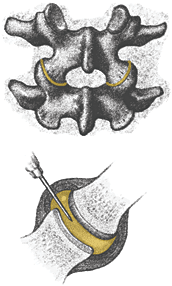Radiofrequency Can Provide
Pain Relief
By Mark Schlimgen, MD, dabpm
Pain Clinic of Northwestern Wisconsin,
Eau Claire
There are multiple sources for back and neck pain, but a common cause is facet joint pain. The facet joints are located at the back side of the spine. There are two joints at each segment along the spine – 46 joints total. Joint pain happens most commonly in the low back or in the neck and occurs in the form of arthritis, generally forming as we age. People with multiple operations are at increased risk for early joint arthritis in the lumbar or cervical spine. The other common source for joint pain is trauma, such as whiplash injury in the neck.
Unfortunately there are no x-rays or scans that will consistently identify joint pain in the spine. Therefore, injections are generally used to identify joint pain. If pain resolves when the joints are anesthetized, then this is felt to be the location of the patient’s pain. Once the location of the pain has been identified, cortisone injections can sometimes be used for treatment. Often patients will undergo a procedure called radiofrequency rhizotomy (also termed “RF”) which is the use of heat to eliminate affected nerve branches and reduce or remove the pain.
Offered as an outpatient procedure, Radiofrequency rhizotomy of the facet joints involves the use of a heated, insulated needle with an exposed tip. The needle is inserted in very close proximity to the small nerve branches that supply the painful joint. Needle placement is confirmed with the use of x-ray guidance. Once the needle is in place, a small electric current travels through the needle to make sure it is in the exact location. Then, radiofrequency waves are used to disconnect the nerve tissue to disrupt pain signals. The pain will generally resolve within a few days of having this procedure.
Radiofrequency rhizotomy has been found to be as much as 70% effective in those patients that have been identified as having joint pain. In patients with cervical whiplash pain that persists longer than two months, Radiofrequency rhizotomy is known to be highly effective. Patients with whiplash injury should be treated conservatively with physical therapy and analgesics for approximately the first two months after the injury. If pain still persists, the ideal time for treatment with radiofrequency rhizotomy is in the two-to-six month’s time frame following a whiplash injury.
Radiofrequency rhizotomy has been statistically shown to significantly reduce pain intensity. This procedure is available at several locations in the Chippewa Valley, including the OakLeaf Surgical Hospital, Eau Claire. If you are experiencing pain that affects your ability to participate in recreational or day-to-day living activities, ask your health care provider about pain management options. There are treatments that can improve your quality of life.
For more information, call Dr. Mark Schlimgen, Pain Clinic
of Northwestern Wisconsin, Eau Claire » 888.235.7246





